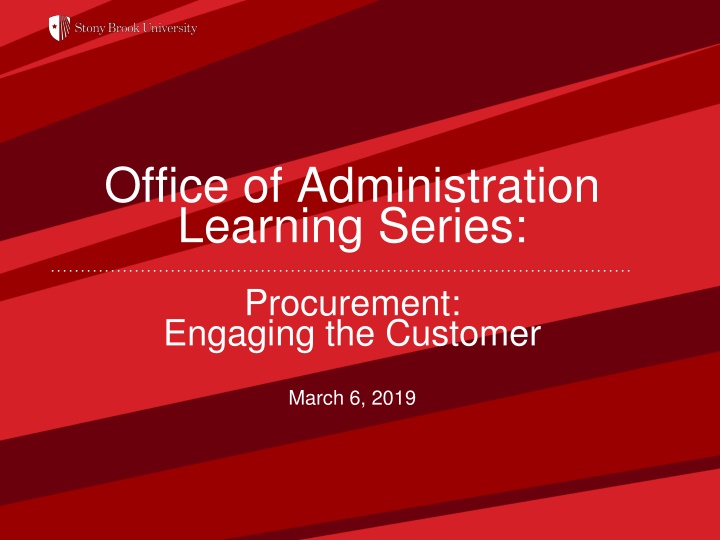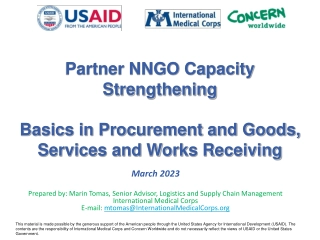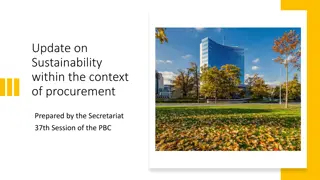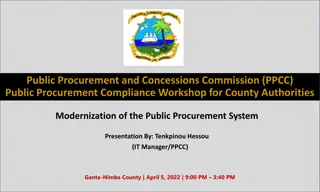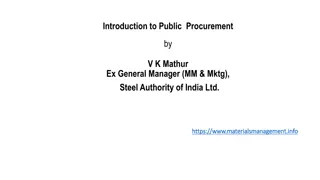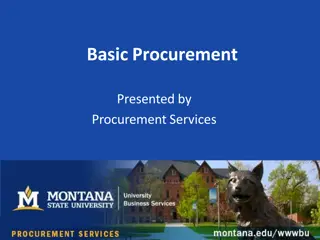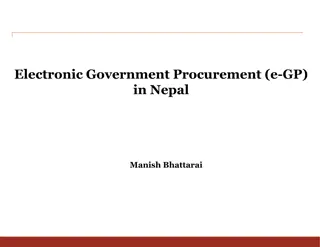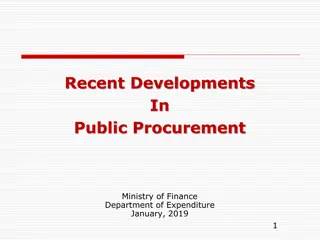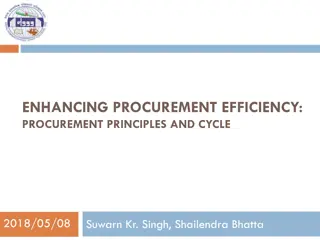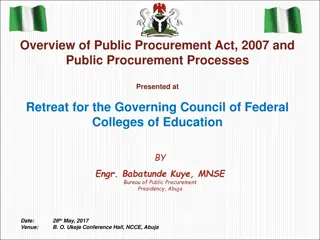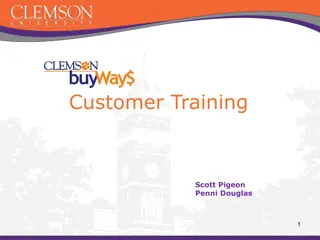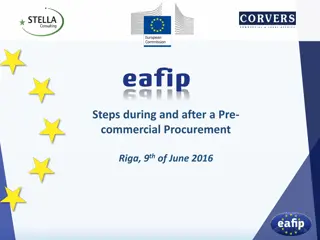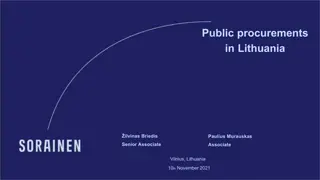Procurement Engagement Guidelines and Process Overview
Learn about the purchasing guidelines, dollar thresholds, and processes for engaging customers in procurement activities. Understand why the procurement process may take longer depending on various factors such as dollar amounts, approval requirements, vendor selection justification, and more.
Download Presentation

Please find below an Image/Link to download the presentation.
The content on the website is provided AS IS for your information and personal use only. It may not be sold, licensed, or shared on other websites without obtaining consent from the author.If you encounter any issues during the download, it is possible that the publisher has removed the file from their server.
You are allowed to download the files provided on this website for personal or commercial use, subject to the condition that they are used lawfully. All files are the property of their respective owners.
The content on the website is provided AS IS for your information and personal use only. It may not be sold, licensed, or shared on other websites without obtaining consent from the author.
E N D
Presentation Transcript
Office of Administration Learning Series: Procurement: Engaging the Customer March 6, 2019
Overview: Purchasing: Guidelines and Dollar Thresholds Single Source/Sole Source Request for Proposal (RFP) Process Food & Dining Wolfmart Forms Accounts Payable and Travel: RF & State Payables RF & State Travel Entire presentation and resources will be uploaded to the Procurement website. 2
Why does the process take so long? Guidelines and Dollar Thresholds. When using NYS funds Purchases > $2,500 require evidence of price reasonableness Purchases > $50,000 require advertisement in the NYS Contract Reporter for a minimum of 15 business days. Services > $50,000 require approval of the NYS Attorney General and NYS Office of the State Comptroller. Purchase of commodities, construction or construction related services does not require AG/OSC approval. When using federally funded sponsored program money Purchases $10,000 to $249,999.99 require 2 written quotes or bids Purchases > $250,000 require a minimum of three written bids or proposals When submitting ALL purchase requests A vendor price quote should be submitted with your requisition that indicates what you are buying and whom the vendor contact is. 3
Why does the process take so long? Help Us, Help You! For software and services the Procurement Office needs sufficient time to process your purchase, generally: 2 to 3 weeks is advised when requesting low dollar services Manual process, often requiring reading and negotiation of multipage agreements, as well as the collection of contractor proof of insurance, potential collection of other exhibits 3 to 6 months are required for a formal purchase (RFP or IFB) on NYS Funds Please plan ahead and invite us to the table in the planning stage so that we can develop a schedule together. Outside approval by NYS Attorney General and Comptroller s Office is required for software and services >$50,000 4
Why does the process take so long? Variables that go into Reviewing Your Request for Software or Services. Can it be provided by a preferred source? Is it on NYS Contract? If so, is a mini bid required? Is it prevailing wage work, Article 8 or 9? Is there travel involved? Is vendor on debarment list? Is there a third party agreement that needs to be read, redlined, negotiated and run past the department and or legal? -Causes Delay Is it a single or sole source? Has dept justified vendor selection? Has the Dept. provided quotes or demonstrated price reasonableness? Does this need to be bid or require a CRER approval? -Causes Delay How much in previous spend do we have with this vendor? Is there a previous PO? Should we be doing a change order? Are we nearing $50K? Are there insurance docs on file? -Causes Delay Are exhibits required if so which ones? -Causes Delay Do MWBE goals apply? -Causes Delay 5
Why does the process take so long? Why do we request vendor proof of insurance? NYS Workers Compensation Laws require agencies to ensure contractors have appropriate workers compensation and disability coverage before we can issue a purchase order or formal contract Commercial General Liability shifts the burden of risk off of the University, which is self insured (i.e. any claims that occur come from the contractor and not out of the department s budget 6
What is a Single or Sole Source Purchase? A single or sole source purchase is a non-competitive purchase, which is subject to increased scrutiny and justification Single/Sole Source Purchases require: Detailed justification explaining why only a certain vendor can be used (what alternative vendors were considered, why they were eliminated, and what makes the requested vendor unique, etc) Detailed justification explaining how the department has determined that the price is fair and reasonable* *Both NYS and RF will accept historical price analyses, educational or governmental discounts off of list prices, or pricing that is less than or equal to vendors other customers, as proof of price reasonableness Link to the campus policy on NYS Funded Single/Sole Sources: https://www.stonybrook.edu/policy/policies.shtml?ID=613 7
What is a Request for Proposal? Request for Proposal (RFP) A best value procurement where a composite score is derived from both cost and technical evaluation criteria Commonly used for selecting enterprise software solutions, technology and complex or professional services Award is not just based on lowest price 8
What is a Request for Proposal? Request for Proposal (RFP) Guidelines and Requirements As the subject matter expert, the department must provide the technical qualifications (functionality) that are required to fulfill the solution that is being sought Evaluation criteria is weighted, with a cost factor worth at least 30% All vendors must be provided with the same requirements to bid on so that proposals can be evenly evaluated and scored It is important to document the strengths/weaknesses of each proposal in order to support supplier selection 9
Whats in Wolfmart .. and whats not in Wolfmart? Wolfmart is NOT Google Showcase Page : What suppliers are up there and why (State and RF spend) Difference between a Hosted Supplier and a Punch-Out Supplier ( Level 2 Functionality) OGS Contracts vs. SBU contracts vs. Loaded Price Files (MWBE + Third Party Suppliers) Balancing convenience and ordering efficiency with finding the absolute best price Expansion of niche suppliers into other commodity groups and why it gets complicated Amazon 10
Which Wolfmart form should I use? Non-Catalog Form: For commodities not in the punch out catalog. Use the blue link at the top of the Wolfmart home page under GO TO . Service Request Form: For repairs, maintenance agreements, printing, software agreements, and anything involving labor. Blanket Order Request Form: When purchasing commodities provided over a specific period of time for contracted or established quantity/pricing. All Blanket Order requests will be reviewed in Procurement. Single/Sole Source Form: When competition would otherwise be required, but is not feasible due to the sole source, single source, or emergency nature of a commodity. Do not use this for Service Single/Sole Source Procurements: use the Service Request Form instead. 11
What if your vendor is not in Wolfmart? 1. Confirm with vendor to make sure he will accept a Purchase Order. Some vendors want to be paid in advance; we want vendors to accept a PO and submit an invoice after delivery of goods or services. 2. Obtain a W-9 (or a W-8BEN for foreign vendors) from the vendor 3. Submit to Procurement via email: procurement_vendorfile@stonybrook.edu 4. Encourage vendor to sign up for ACH payments: https://osc.state.ny.us/vendors/epayments.htm 5. If the vendor does not accept a PO consider using your State P-card instead 12
How can I order food? Catered Food: All catered food requires a purchase order in advance of the event When planning an event, please provide documents to support these three questions: WHAT ? Written quotation from vendor WHO ? List of invitees/attendees WHY ? Justification/Description of Event Review and confirm you are within the allowable daily meal rates per person: Breakfast: $ 14.00 Lunch: $ 25.00 Dinner: $ 57.00 Food can be ordered using either State or IDC funds. Food can be ordered for events with outside guests, students or when recruiting employees. Food/beverages may not be ordered by faculty and staff when they are engaged in routine University business 13
How can I order food? Which Forms to Use in Wolfmart: Non-Catalog Form: For food delivered on campus Non-Encumbered Form: For dining out in restaurants Service Request Form: When food is provided at a conference facility and may include a contract to be signed in Procurement References: SBU Policy: https://www.stonybrook.edu/commcms/procurement/employees/purchasing/sta te-procurement#FoodPayments-Reimbursement Call 2-6071 for State food purchases or 2-6056 for RF food purchases 14
What do I do with an invoice that I received from a vendor? Invoices If your departments receives an invoice from a vendor please approve the invoice for payment and mail the invoice to the Procurement Office for payment processing. All original invoices must be sent by the vendors to the Procurement Office (we are the designated payment office for the University, Hospital, and LISVH) RF invoices totaling $25,000.00 and over require departmental payment approval. 15
What am I responsible for when Im approving an invoice for payment? Invoice Approval Process - The Department s Responsibility: By approving an invoice for payment you: Are certain the goods have been received/services have been completed Know where the goods are located Know that the received equipment has been properly tagged for Property Control purposes Can clearly show that the vendor s services were performed Can document with clear, detailed records, when the vendor s employees arrived to begin work and when they clocked out each day 16
What do I do if my order has damaged or missing items? Invoice Approval Process - The Department s Responsibility: Respond within 3 to 5 business days, to requests for invoice payment approvals via a WolfMart comment. Your comment should include the date the goods were received or the date services were rendered. **Important: NYS Prompt Payment Legislation - New York State pays interest for late payments issued to vendors. Invoice/Order Issues - The Department s Responsibility: Departments must advise the Procurement Office of any invoice, service, or order issues by submitting a WolfMart comment that lists the discrepancies. This must be done as soon as the issue arises. 17
Whats the payment status of my invoice? General Guidelines Both RF and State A/P perform a three-way match between: Purchase Order Invoice Receipt of goods or payment approval from department via a WolfMart comment **RF invoices over $25,000.00 also require department payment approval Departments can view voucher payment information on: WolfMart voucher (for both RF and SUNY) SUNY BI (State) Oracle Report Center (RF) RF invoices totaling $25,000.00 and over require departmental payment approval. 18
How do I find and calculate per diems for Lodging and Meals? How to find Per Diem rates for Lodging: Receipted Lodging method provides for a reimbursement of lodging costs and a per diem allowance for meals and incidental expenses, based on federal reimbursement rates. Receipts are required for lodging, not for meals Lodging within NYS is tax exempt (use certificate ST-129) When using the Receipted Lodging Method use the following links to look up the per diem rates Domestic Per Diem Travel Rates: https://www.gsa.gov/travel/plan- book/per-diem-rates Foreign Per Diem Travel Rates: https://aoprals.state.gov/web920/per_diem.asp You cannot exceed the lodging per diem rate without proper justification and pre- approval of your supervisor. 19
How do I find and calculate per diems for Lodging and Meals? How to calculate meal per diems when using the Receipted Lodging Method: Domestic Travel: find the meal & incidental expenses (M&IE) total from the GSA site than use the meal allowance breakdown chart below to determine the breakdown between breakfast and dinner. October 1, 2018 September 30, 2019 Meals and Incidental Expenses Total Breakfast Dinner $76 $15 $61 $71 $14 $57 $66 $13 $53 $61 $12 $49 $56 $11 $45 $55 $11 $44 20
How do I find and calculate per diems for Lodging and Meals? How to calculate meal per diems when using the Receipted Lodging Method: Foreign Travel: find the meal & incidental expenses (M&IE) rate from the U.S. Department of State website. Foreign per diem rates are published monthly. https://aoprals.state.gov/web920/per_diem.asp The total of meal per diem is calculated at 20 percent for breakfast and 80 percent for dinner. 21
How can I avoid out of pocket expenses for Airfare/Amtrak? Methods for Purchasing Airfare/Amtrak Tickets may be purchased without any out of pocket cost to the Traveler through Euro-Lloyd the dedicated University Travel Agency Individual Travel Account (ITA)Tickets for State Employees traveling on State funds may be purchased using a ITA account Non-Employee Travel Account (NET)Tickets for non-state employees including RF Employees traveling on State funds may be purchased using a NET account Business Travel Account (BTA)Tickets for all employees and non-employees traveling on RF funds may be purchased using the BTA account Employees traveling on RF funds may request a pre travel cash advance to purchase tickets 22
When can I use my personal car for travel? A personal vehicle may be used for business purposes when a State vehicle, rental vehicle, or common carrier is not available, is not cost effective, or is otherwise not appropriate. When using your personal car for business, you will be reimbursed at the IRS business mileage rate. This rate includes all charges for gasoline, oil, accessories, repairs, depreciation, anti-freeze, towing and insurance on your car. Rules and Regulations Employees MUST perform a cost comparison between renting a car and driving their own vehicle. When supported by proper justification, personal vehicles may be used due to extenuating circumstances. Employees who choose to use their personal vehicle solely based on personal preference will be reimbursed at the lesser of the two costs. Trip Calculators can be used to assist travelers in determining most cost effective method of transportation: https://www.ogs.ny.gov/bu/ss/trav/calculators.asp 23
What travel expenses are reimbursable? Reimbursable Expenses: Miscellaneous Expenses o Parking o Tolls o Internet for business o Business Calls o Baggage Fees o Registration Fees Transportation o Airfare o Train o Rental Car o Mileage o Bus o Taxi o Subway o Car Service Foreign Travel o Passport Fees o Visa Fees o Foreign Exchange Fees Lodging Meals (lunch is not) 24
What travel expenses are non reimbursable? Non Reimbursable Expenses: Airline/trip Insurance Speeding Fines Laundry Parking Tickets Entertainment Transportation to and from meals Tips to hotel staff Early bird check in charges Tips for curbside check-in Seat upgrades 25
Questions? 26
